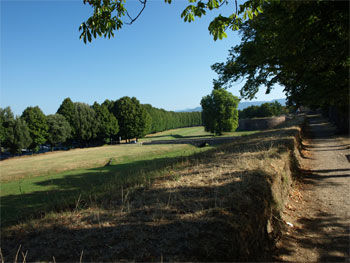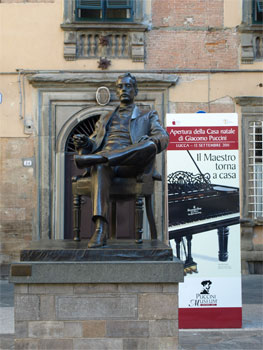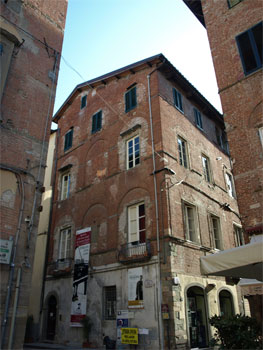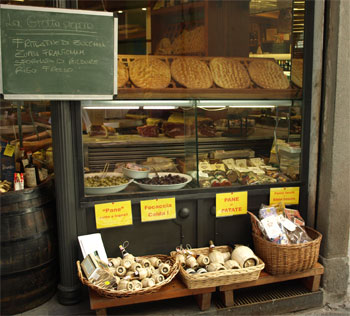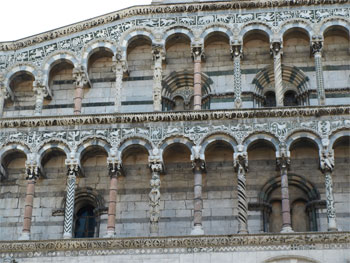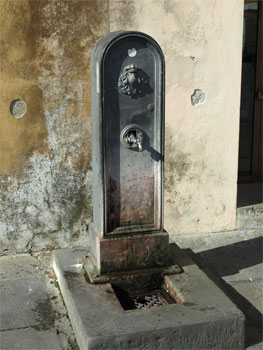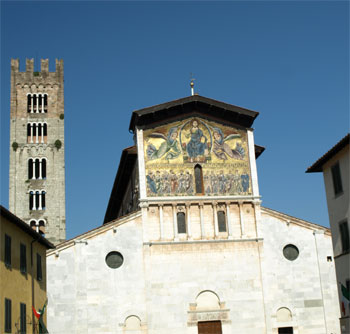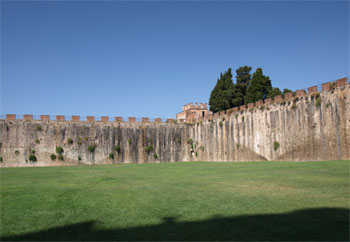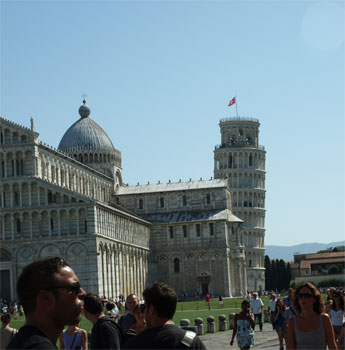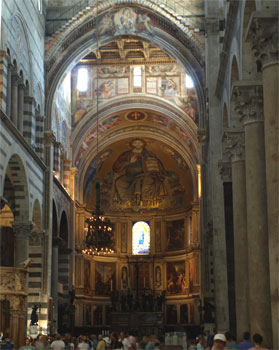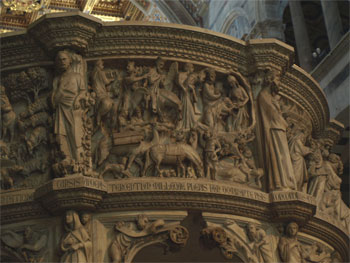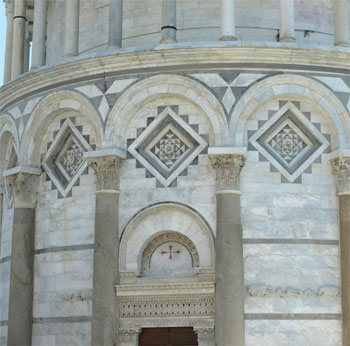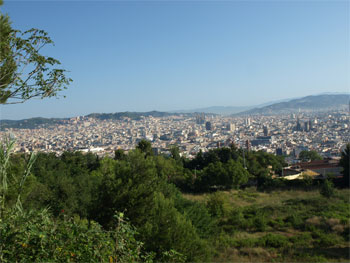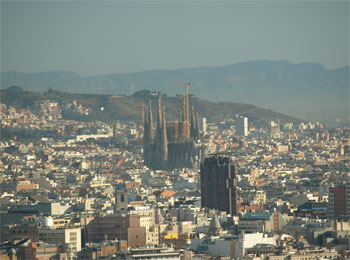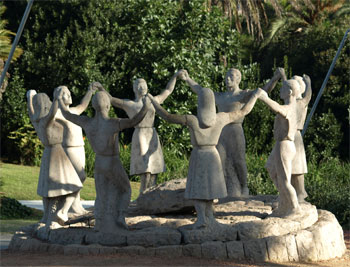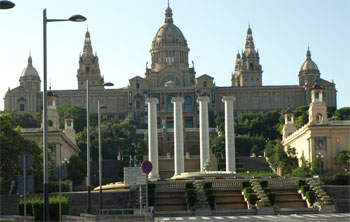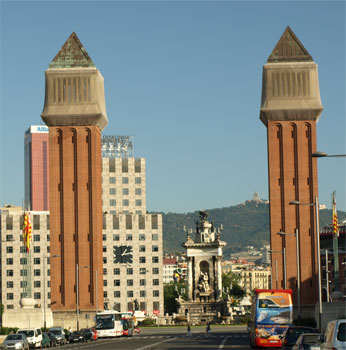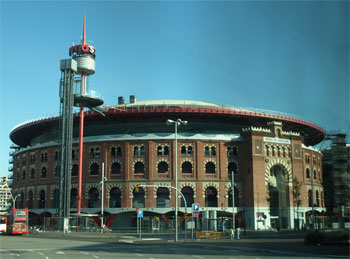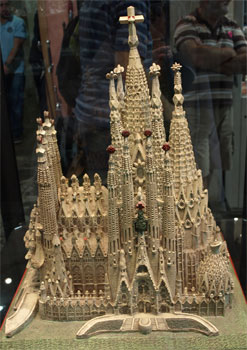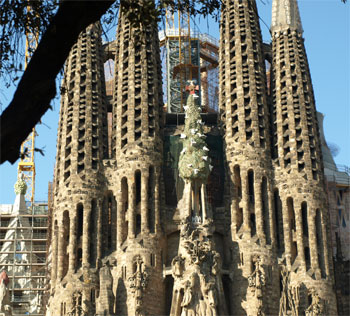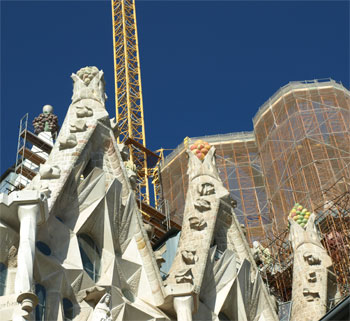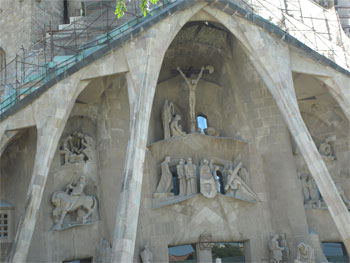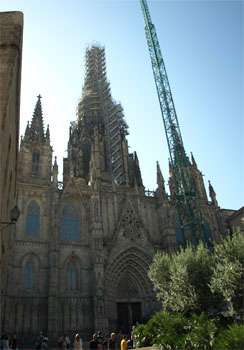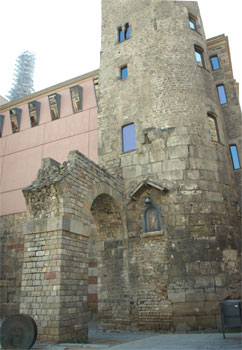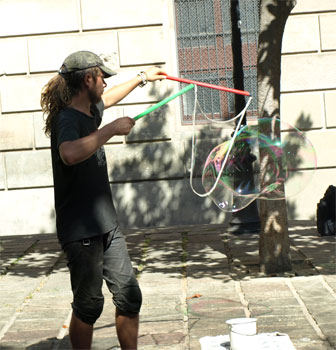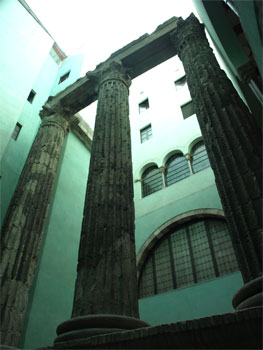Fri., 8/19/11 - Livorno, Italy - Lucca and Pisa
This morning we took another tour in the heat and humidity, this time to Lucca and then on to Pisa. Lucca is a city originally walled by the Romans and later enlarged, as the city grew larger. The walls have been maintained as a wide walking and cycling path. It is like a 4 km long park around the city. It was planted with chestnut trees 200 years ago and they now provide a very pleasant area.
Lucca was a town that created silk cloth (most of the silk thread came from Asia) specially embroidered with gold and silver thread. It was a very rich city and therefore the fortified walls were necessary. The mountains around the town are rich in Carrara marble. The white on the mountaintops is not snow, but marble.
Walls of Lucca |
Walking/cycling path on top of the walls
|
Puccini was born in Lucca. His statue is in the square near his house. He was a musical genius but a real rogue - he smoked about 70 cigarettes a day and had many women. He was very rich, so his wife stayed with him.
|
|
Statue of Puccini
|
Puccini's birthplace |
Luigi Boccherini was also born in Lucca
|
|
St. Michael's Church and square are built on the site of an old Roman forum. It is built of the local grey and white Carrara marble and is quite elaborate on the outside incorporating several architectural styles - Roman arches, decorated columns, carvings, replicas of traditional silk designs, etc.
|
Facade of St. Michael's Church
|
At the end of the street is a just visible building with trees on the top which was a Medici home.
|
Fountain in the square |
We went into the Basilica of San Frediano. The front facade has a mosaic of Jesus ascending into heaven and the 12 apostles are shown below him. Inside we sat in the chapel of St. Zita. She was a servant who found ways to feed and clothe the poor. One time she had an apron full of bread loaves and when the mistress asked her what she was hiding, she opened the apron and the bread had changed to flowers! (A flower festival is held in her honor each year.) Another "miracle" is her mummified body lying at the altar of the chapel. She was not embalmed, but her body is preserved inside the glass coffin.
|
Basilica of San Frediano
|
Back to the bus and on to Pisa. We had a long walk from the bus to the Field of Miracles, which is the grassy park where the Baptistery of St. John, the cathedral (or Duomo), leaning bell tower (Tower of Pisa), and ancient cemetery (Campo Santo) are located.
Wall around the Field of Miracles |
View of the Cathedral and the Leaning Tower
|
Baptistery of St. John
|
The Baptistery is round and made of white marble. The cathedral is also elaborate white marble and was built in 1063. The inside had many huge but dark paintings and a ceiling of wood and gold paid for by the Medici family.
|
Exterior of the Cathedral |
Cathedral interior
|
Interior closeup |
Of course, the leaning bell tower is the main attraction. The soft soil below the three-meter deep foundation could not support the weight of the marble structure. After the third tier was erected, it was obvious it was going to lean, so the architects bent the next tiers in the opposite direction. It created a "slight banana" curve. There are seven bells in the bell tower that could not be rung because the vibration would create more instability. An internal stabilizing column helped some. In 1990 an international group sought solutions. They removed some soil from the high side and straightened the tower by 12 cm. Other stabilizing efforts stopped the tower from increasing the lean and it is now supposed to be stabilized for the next 300 years.
|
The leaning bell tower
|
Details on the first tier |
Sat., 8/20/11 - At Sea - docking at 6 PM in Barcelona, Spain
This was a day of recovery. Washing a bunch of clothes in the tub was the only activity. We ate a nice breakfast in the dining room, ate salads for lunch, and then went to high tea and ate little sandwiches and scones. I finally had time and energy to attend a culinary lesson - making Spanish tapas or appetizers.
We arrived a half-hour late in Barcelona, perhaps, because of the heavy fog we sailed through around noon. It was sad to say goodbye to Jose and Ana, Pat and Stan, but we all exchanged e-mails and Jose will send us a group photo.
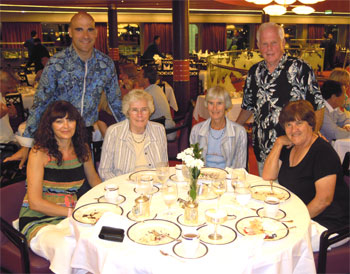
Ana, Jose, Marge, Gale, Stan, Pat
Sun., 8/21/11 - Barcelona, Spain
This morning was a "turn over" day. Many people ended the cruise and many more joined us for the next seven days. It was a wise decision we made to take a tour around Barcelona and avoid the disembark/embarkation madhouse.
Our motor coach first drove us up to Montjuic, one of the hills of Barcelona. This park has a fortress up on top, many overlooks of the city, and a huge botanical garden. Montjuic means Jewish mountain and at one time there were many Jewish merchants operating in this part of the city.
Barcelona from Montjuic
|
Barcelona from Montjuic - Gaudi's Church of the Holy Family is in the center |
Barcelona from Montjuic - Monument to Columbus
|
Monument to Sardanes folk dancing on Montjuic |
|
|
Royal Palace |
Venetian Towers with a large fountain in the Plaza d'Espanya beyond
|
Arenas de Barcelona - the old bullring
|
Casa Batllo - designed by Antonio Gaudi
|
Antonio Gaudi was an avant-garde architect who created many very unusual, creative buildings in this city around 1900. We passed several of his house creations.
|
|
Model of Gaudi's Sagrada Familia - East or Nativity facade
|
Model of Gaudi's Sagrada Familia - South facade |
Model of Gaudi's Sagrada Familia - West facade
|
Model of Gaudi's Sagrada Familia - North facade |
Gaudi's Sagrada Familia - East or Nativity facade
|
Gaudi's Sagrada Familia - East or Nativity facade |
Gaudi's Sagrada Familia - South facade
|
Gaudi's Sagrada Familia - West facade - Gaudi self-sculpture on left in lower level of central niche |
We boarded the bus and rode to the Gothic Quarter, dating to the medieval ages, 12 - 15th centuries. We went inside the Cathedral de Barcelona that has some gilded chapels. The church has a cloister with 13 white geese in honor of the 13 year-old girl (St. Eulalia) martyred during the Tetrarchy of Diocletian (293-313 AD) because she would not worship the Roman gods. |
|
Barcelona Cathedral or Cathedral of the Holy Cross and Saint Eulalia |
Roman aqueduct and wall
|
Making giant bubbles
|
We walked to the area where the Romans built their temple to the Emperor, C. Augustus. Four of the original columns remain adjacent to a four-story apartment.
|
Our group was small, it was Sunday while most of the country is "on holiday" and there was not much traffic so we had time to drive around the Olympic Village area. We took pictures of the golden fish sculpture by Frank Gehry that serves as a landmark for the area, the Olympic marina, and the Barcelona beaches.
|
Gehry's golden fish at the Olympic Village
|
| Return to Top | Return to Itinerary | Return to Dreamcatcher Home Page |

